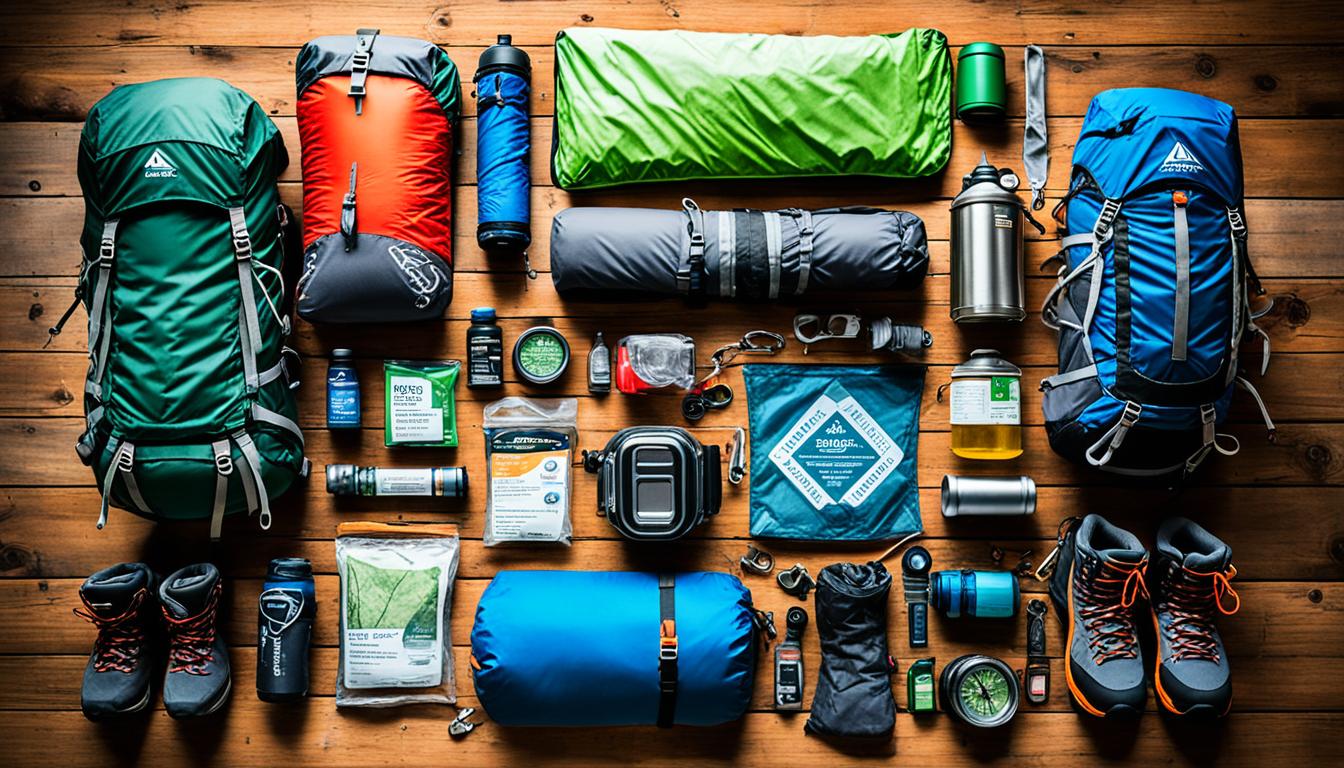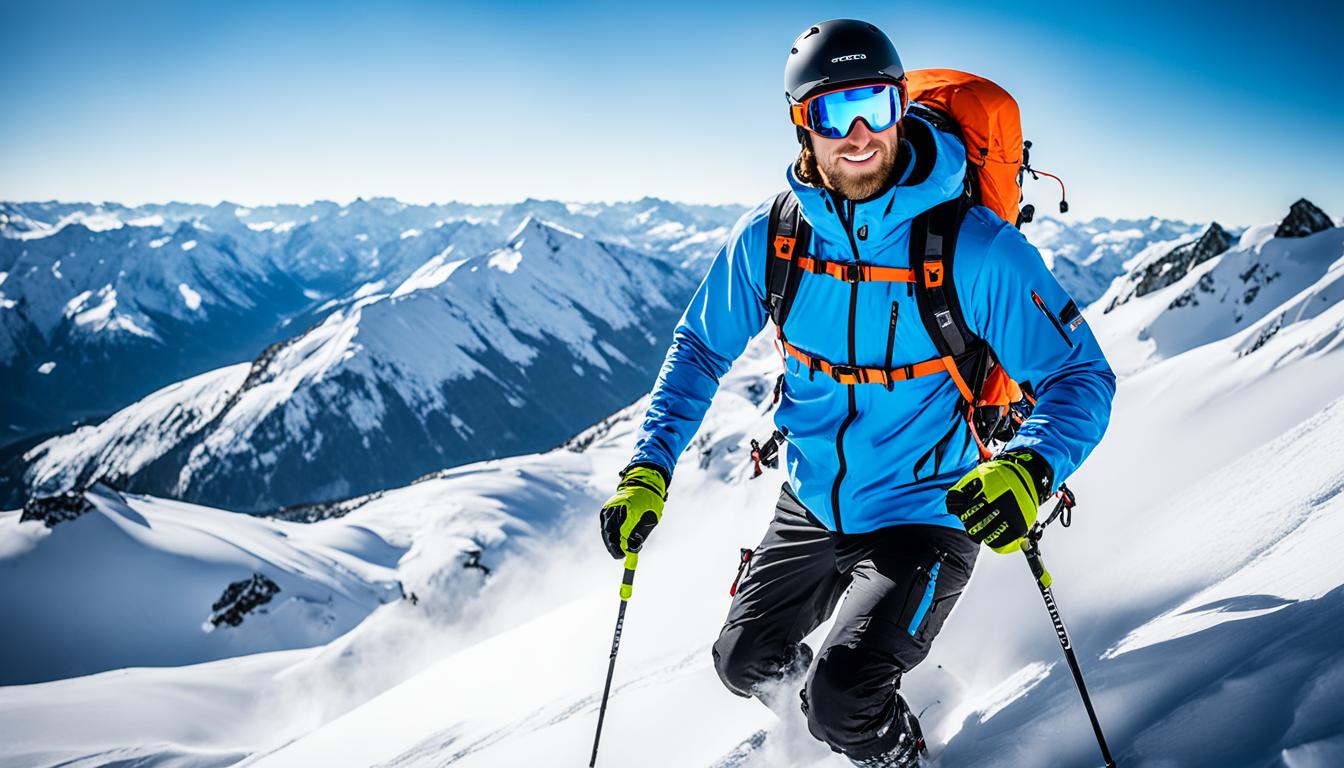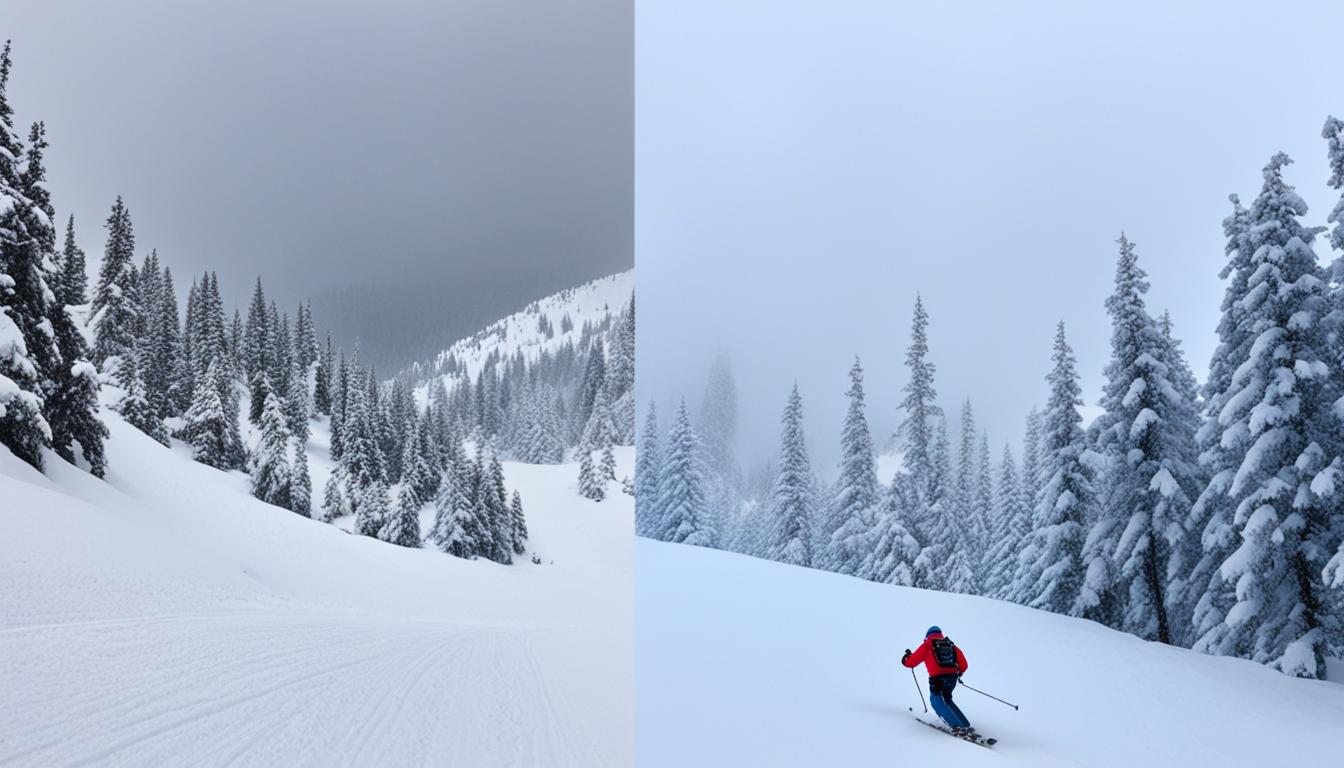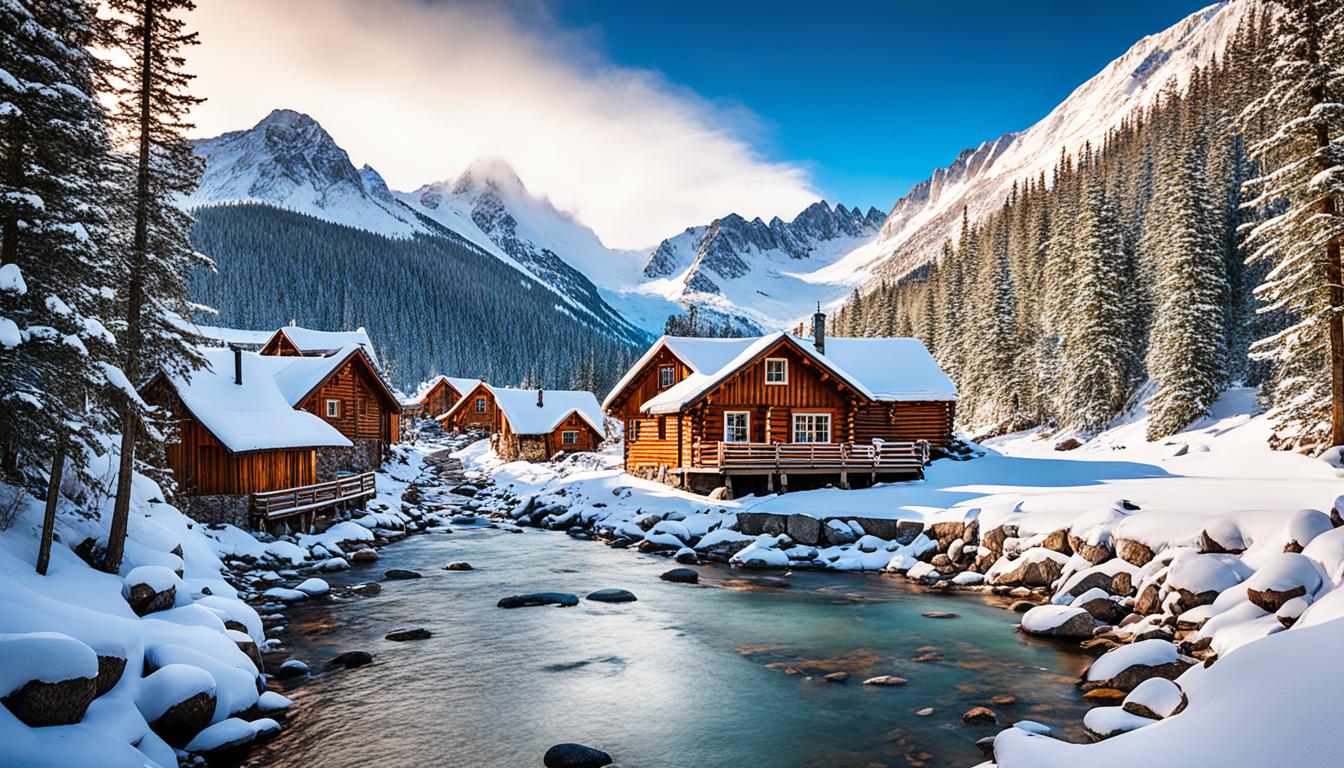A backpacking adventure can be life-changing if you have the right gear. This list includes everything you need for a backcountry trip. It covers essentials for three-season trips, without special needs like snow or desert camping.
The list is from trusted sources and years of outdoor experience.
Key Takeaways:
- Packing list for a backcountry adventure includes essential gear for a successful trip.
- Backpacks, tents, sleep systems, water storage and filtration, stoves and cookware, food and snacks, apparel, footwear, personal hygiene items, electronics, and navigation are must-haves.
- Consider factors such as weight, durability, comfort, and fit when choosing gear.
- Invest in gear from reliable brands for long-term use.
- Building a gear collection can be a gradual process—start with essential items and expand over time.
Backpacking Gear Checklist
Planning a backcountry trip needs the right gear for safety and fun. This checklist covers every item you need. It includes camping gear and personal essentials for a successful journey.
Essential Gear
A reliable backpack is your first priority. Find one with lots of room, comfy straps, and tough materials. Don’t forget a strong tent or hammock for shelter. Pick the size and weight that fits your plans.
| Essential Gear | Recommended Brands |
|---|---|
| Backpack | Osprey, Deuter |
| Tent or Hammock | Big Agnes, ENO |
A quality sleep system is key to a good rest. Pair a sleeping bag or quilt with a cozy pad for warmth and comfort all night.
| Sleep System | Recommended Brands |
|---|---|
| Sleeping Bag/Quilt | Therm-a-Rest, Western Mountaineering |
| Sleeping Pad | Therm-a-Rest, Sea to Summit |
For staying hydrated, take along water storage and filtration. Use light bottles or reservoirs and reliable filters for clean water.
| Water Storage/Filtration | Recommended Brands |
|---|---|
| Water Bottles/Reservoirs | Nalgene, Camelbak |
| Filtration System | Sawyer, Katadyn |
Prepare meals with a stove and cookware. Choose lightweight, compact sets that you can easily use and clean.
| Stove and Cookware | Recommended Brands |
|---|---|
| Stove | MSR, Jetboil |
| Cookware Set | GSI Outdoors, Snow Peak |
Essential Supplies
Don’t forget enough food and snacks. Pick items that are light, don’t spoil, and give you energy.
Bring the right clothes for any weather. Include socks that wick moisture, quick-dry underwear, and layers for warmth, from t-shirts to jackets. Don’t forget hats, sunglasses, gloves, and rain gear.
Choose sturdy hiking boots or shoes that fit well and support your ankles. Pack some camp shoes too for relaxing times.
Even in the wild, personal hygiene is a must. Bring toiletries, toilet paper, hand sanitizer, sunscreen, bug spray, and other necessities.
Always carry maps and a compass to stay on the right path.
| Essential Supplies | Recommended Brands |
|---|---|
| Food and Snacks | Mountain House, Backpacker’s Pantry |
| Apparel and Footwear | Patagonia, Columbia, Merrell |
| Personal Hygiene Items | Sea to Summit, REI Co-op |
| Navigation Tools | Suunto, Garmin |
With this guide, you’re set for your next outdoor journey. Remember to pick gear that suits your needs. Happy hiking!
Choosing the Right Gear
Getting ready for a backcountry adventure means picking the right stuff. Think about how heavy, strong, comfy, and well-fitting your gear is. This helps make your trip both fun and smooth. Here are some key things to think about:
- Backpacks: Find a backpack that can hold what you need, with the right features and made from good materials. Make sure it fits well for those long hikes.
- Tents: You can choose between regular tents, tarps, or hammocks. Pick what you like best for roominess and keeping dry.
- Sleep Systems: Look at sleeping bags’ temperature ratings and how warm they keep you (the R-value). Choose sleeping pads too, for a good sleep.
- Water Storage and Filtration: There are lots of ways to carry and clean water. You might pick bottles, filters, or UV purifiers for safe water.
- Stoves and Cookware: Think about what you’ll cook and choose a stove accordingly. You can pick canister stoves, liquid fuel types, or something else.
- Food and Snacks: Take plenty of energy foods like nuts, cheese, and olive oil. They help you stay strong on your trip.
- Apparel: Get the right clothes for the weather, including socks, pants, shirts, and jackets. Don’t forget hats, sunglasses, gloves, and rain gear.
- Footwear: Pick shoes or boots that are comfy and support you. Depending on the ground you’ll cover, you might want hiking boots or light shoes.
- Personal Hygiene Items: Remember to bring toiletries, toilet paper, sanitizer, sunscreen, and bug spray. For women, pack what you need for periods.
- Navigation Tools: Maps, compasses, and GPS help keep you on the right track out in the wild.
Don’t forget about first aid kits, repair tools, personal stuff, electronics, and safety gear like bear spray. The right gear makes sure you’re ready for your adventure.
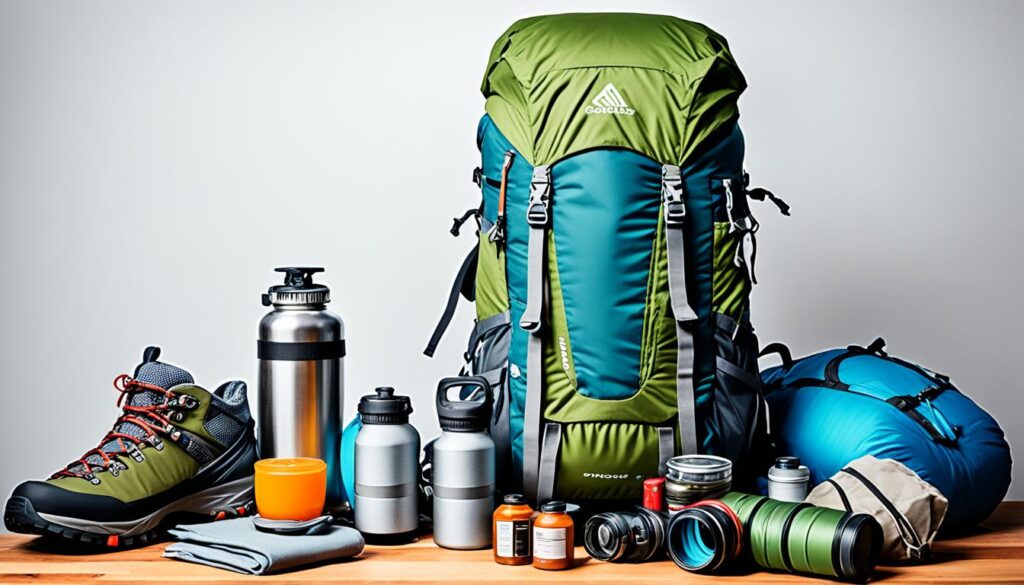
Tips for Building Your Gear Collection
Starting a gear collection for backpacking takes time. It’s key to have the right tools for fun and safety. Follow these steps to grow your collection:
Invest in gear that lasts
Choose gear that’s tough and stays good for years. Pick from well-known brands for quality. Your gear should survive challenging trips and last through many adventures.
Take advantage of sales and discounts
Gathering gear can be costly, but it doesn’t have to be. Keep an eye out for sales and clearances both online and in stores. This way, you can get your gear for less.
Borrow gear or buy second-hand
If money’s tight, think about borrowing or buying used. Friends might let you use their gear. Or, you can get good deals online or at swap events for outdoor items.
Consider repair options and warranties
Good gear often comes with ways to fix it or warranties. Before buying, see if the brand has repair services. A good warranty can save you from buying new gear.
Don’t forget the Ten Essentials
Always bring the Ten Essentials when going into the wilderness. These items are vital for staying safe and comfortable outdoors. Pack them with care in your gear bag.
Safety comes first, always. Equip yourself properly for a great and secure backpacking trip.
Lastly, consider the Leave No Trace principles. They keep our outdoor spots beautiful and ready for those who come after us.
Leave No Trace Principles
1. Plan Ahead and Prepare: Work out everything ahead to lessen your impact.
2. Travel and Camp on Durable Surfaces: Stay on paths and campgrounds that can handle you.
3. Dispose of Waste Properly: Carry out all trash and handle waste right.
4. Leave What You Find: Keep nature as you found it, without disturbing it.
5. Minimize Campfire Impact: Use fire rings or stoves and keep fires small.
6. Respect Wildlife: Watch wildlife from afar and don’t give them food or come close.
7. Be Considerate of Other Visitors: Keep noise down and respect others’ experiences.
With these guidelines, pick gear that fits your needs and helps keep our outdoor places clean.
Recommended Backpacking Gear
To kick off your collection, here are some options:
| Category | Recommended Gear |
|---|---|
| Tents | Big Agnes Copper Spur HV UL2 |
| Sleep Systems | Feathered Friends Hummingbird YF 20 sleeping bag |
| Therm-a-Rest NeoAir XLite NXT sleeping pad | |
| Water Filtration | Sawyer Squeeze |
| Platypus GravityWorks 4L | |
| Backpacking Stoves | MSR PocketRocket 2 |
| Jetboil Zip Cooking System | |
| Backpacking Food | Backpacker’s Pantry |
| Hiking Footwear | Salomon, Danner, Merrell |
| Personal Hygiene | Sea to Summit, MEC |
| Navigation Tools | Maps, compasses, GPS devices |
There are many more options out there. Pick what meets your needs best for a great backpacking adventure.
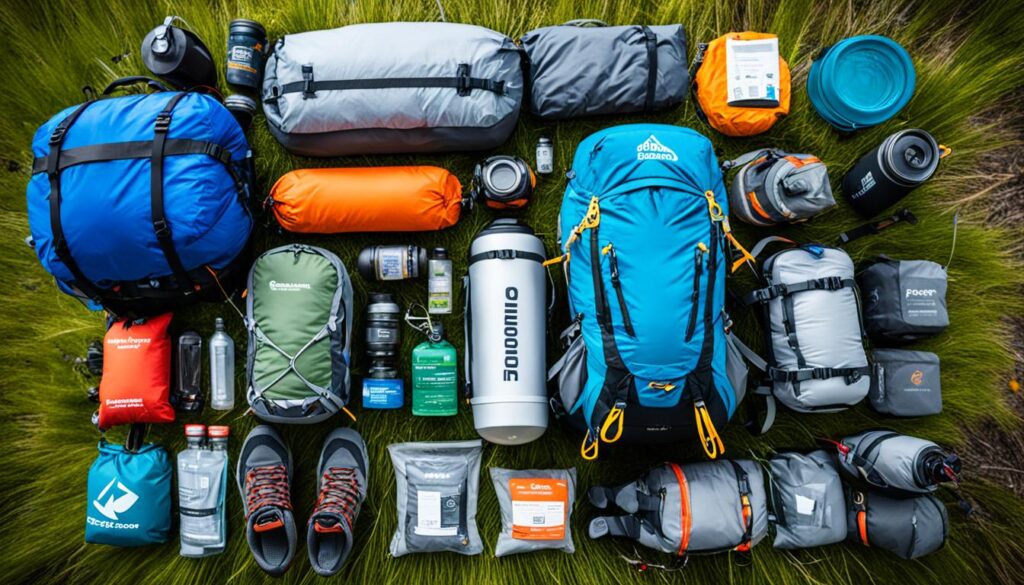
Recommended Backpacking Gear
Planning a backpacking adventure? Having the best gear is key. After years of exploring outside, I’ve found some great gear. These picks mix quality, performance, and trustworthiness.
Tents
For a good night’s sleep, you need a solid tent. The Big Agnes Copper Spur HV UL2 and MSR Hubba Hubba NX2 are top choices. They’re light, tough, and have lots of room.
Sleep Systems
Getting a good sleep system means you’ll be ready to hike each day. The Feathered Friends Hummingbird YF 20 bag and Therm-a-Rest NeoAir XLite NXT pad are very comfy and warm.
Water Filtration Systems
Clean water is a must. The Sawyer Squeeze and Platypus GravityWorks 4L systems are easy and reliable for filtering water.
Backpacking Stoves
A good stove heats meals fast on the trail. The MSR PocketRocket 2 and Jetboil Zip Cooking System are reliable and quick.
Backpacking Food
Bring easy, tasty meals for your trip. Brands like Backpacker’s Pantry have many delicious options. They keep you energized during your journey.
Hiking Footwear
Good shoes are vital for comfy hiking. Brands like Salomon, Danner, and Merrell have boots for all terrains and tastes.
Personal Hygiene Items
Keeping clean outdoors is crucial for comfort. Sea to Summit and MEC have light personal care items. This includes toiletries and items for hygiene.
Navigation Tools
Staying on course means having the right tools. Carry maps, a compass, and maybe a GPS. They will help you navigate safely and correctly.
Here are just a few gear ideas for your trip. Pick what works best for you. The right gear ensures you have the best time on your adventure.
Conclusion
A well-prepared backpacking gear checklist is vital for a great adventure. It ensures you have everything you need for the trip. This includes camping essentials and hiking gear, which are key for your comfort and safety.
When making your checklist, think about the weight of the items. Also, consider how well they will last and what you really need. Choosing the best equipment means looking at brands known for quality. Think about brands like Big Agnes, MSR, and Therm-a-Rest for your needs.
The right gear lets you enjoy the wilderness to the fullest. It helps make your trip unforgettable. So, check your pack again, ensure you have all you need, and get ready for a fantastic adventure. Happy hiking!
FAQ
What are the essentials for a backcountry adventure?
A backcountry adventure needs key items like backpacks and tents. Don’t forget sleep gear, ways to carry and clean water, plus stoves for cooking. You’ll also want plenty of food, the right clothes and shoes, and personal care products. Electronics and a way to navigate are vital too.
How do I choose the right gear for a backcountry adventure?
Choosing the best gear means thinking about size, strength, comfort, and how it fits you. Look online for options, check out what others say, and think about what you like and need.
How can I build my gear collection for backpacking?
Start your gear collection by getting quality items from trusted brands. Look for sales and used items to save money. You can also borrow gear if you’re just starting out.
What are some recommended backpacking gear options?
Great gear includes tents like the Big Agnes Copper Spur HV UL2 and sleeping bags like the Feathered Friends Hummingbird YF 20. For sleeping pads, try the Therm-a-Rest NeoAir XLite NXT. Stay hydrated with the Sawyer Squeeze or Platypus GravityWorks 4L. Cook with the MSR PocketRocket 2 or Jetboil Zip.
What should I keep in mind when packing for a backcountry adventure?
Packing smart means choosing light, strong, and personal items. Think about the weather and pack the right clothes and shoes. Remember to bring a map, first aid, and anything else your trip needs.

